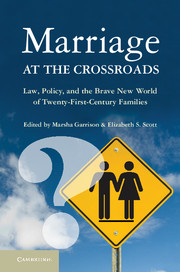Book contents
- Frontmatter
- Contents
- Contributors
- Acknowledgments
- Introduction
- Part I History, Demographics, and Economics – Multiple Perspectives on Families
- Part II Empirical Research on Family Change
- 6 Institutional, Companionate, and Individualistic Marriages
- 7 Marriage and Improved Well-Being
- 8 Fragile Families
- 9 Should Marriage Matter?
- Part III Family Policy and Law for the Twenty-First Century
- Comments
- Index
- References
6 - Institutional, Companionate, and Individualistic Marriages
Change over Time and Implications for Marital Quality
Published online by Cambridge University Press: 05 November 2012
- Frontmatter
- Contents
- Contributors
- Acknowledgments
- Introduction
- Part I History, Demographics, and Economics – Multiple Perspectives on Families
- Part II Empirical Research on Family Change
- 6 Institutional, Companionate, and Individualistic Marriages
- 7 Marriage and Improved Well-Being
- 8 Fragile Families
- 9 Should Marriage Matter?
- Part III Family Policy and Law for the Twenty-First Century
- Comments
- Index
- References
Summary
The institution of marriage has changed more during the last fifty years than in any comparable period in American history. With respect to demographic trends, age at first marriage increased, cohabitation became common as a prelude to marriage, the divorce rate rose, and the percentage of marriages in which one or both spouses had been married previously increased. Changes also occurred in spousal relationships: wives increasingly entered the labor force and became co-providers, husbands took on a larger share of household chores and child-rearing responsibilities, and decision-making equality between spouses became common. Corresponding to changes in behavior were shifts in attitudes toward marriage and family issues, with people becoming more accepting of alternatives to the traditional two-parent, heterosexual family. As these changes unfolded, a society-wide debate emerged about whether these trends have had positive or negative implications for adults and children (e.g., Popenoe 1993; Stacy 1996).
Most scholars have described, explained, and considered the implications of these changes by focusing on one variable at a time. In contrast to a single-variable approach, a typological (or person-centered) approach considers how multiple marital characteristics cluster into naturally occurring types. In this approach, marriages rather than variables serve as the focus of analysis. In this chapter, I adopt such a marriage-focused perspective. Specifically, I use cluster analysis to group marriages into institutional, companionate, and individualistic types. I then show how the frequency of these three types of marriages in the U.S. population changed between 1980 and 2000. My analysis also reveals how marital quality and stability vary across these groups. As I hope to show, a typological approach provides a useful supplement to conventional approaches that focus on types of variables rather than types of marriages. The conclusion of this chapter addresses some policy implications of this research.
- Type
- Chapter
- Information
- Marriage at the CrossroadsLaw, Policy, and the Brave New World of Twenty-First-Century Families, pp. 107 - 125Publisher: Cambridge University PressPrint publication year: 2012
References
- 11
- Cited by

